Paleo - Position of the South China Craton in the Rodinia Supercontinent: Evidence from the U - Pb age and Hf isotope of detrital zircon from the Nam Co Complex
To constrain the paleo - positions of the South China Cratons in the Rodinia
Supercontinent during the Neoproterozoic, the in - situ U - Pb dating, and
Hf isotope analysis of the detrital zircon from the Nam Co Complex, Song
Ma Suture zone, northwestern Vietnam was performed. The U - Pb isotopic
dating on detrital zircons shows that the Nam Co Complex demonstrates
the major population (>50%) of around ~850 Ma while the minor
population is scattered between ~1.2÷3.0 Ga. The Neoproterozoic age
spectrum exhibits a large range of the εHf(t) from strongly negative to
positive values ( - 17.418022÷ 14.600527), indicating that the source of the
magma for this age range has been not only derived from reworking of the
Archean basement rocks, but also generated from the juvenile material. The
U - Pb age distribution patterns and Hf isotopic data of the detrital zircon
in the Nam Co Complex are compatible with those of the South China Craton
rather than those of the Indochina Craton. The data also indicate that
sedimentary protoliths of the Nam Co Complex were deposited in a
convergent - related basin along the southwestern margin of the South
China Craton during the Neoproterozoic. Combined with the similarities of
the detrital zircon age between western Cathaysia, Indochina, East
Antarctica and East India, it is proved that the South China Craton was
situated at the margin of the Rodinia Supercontinent and in close proximity
to the Indochina, East Antarctica and East India
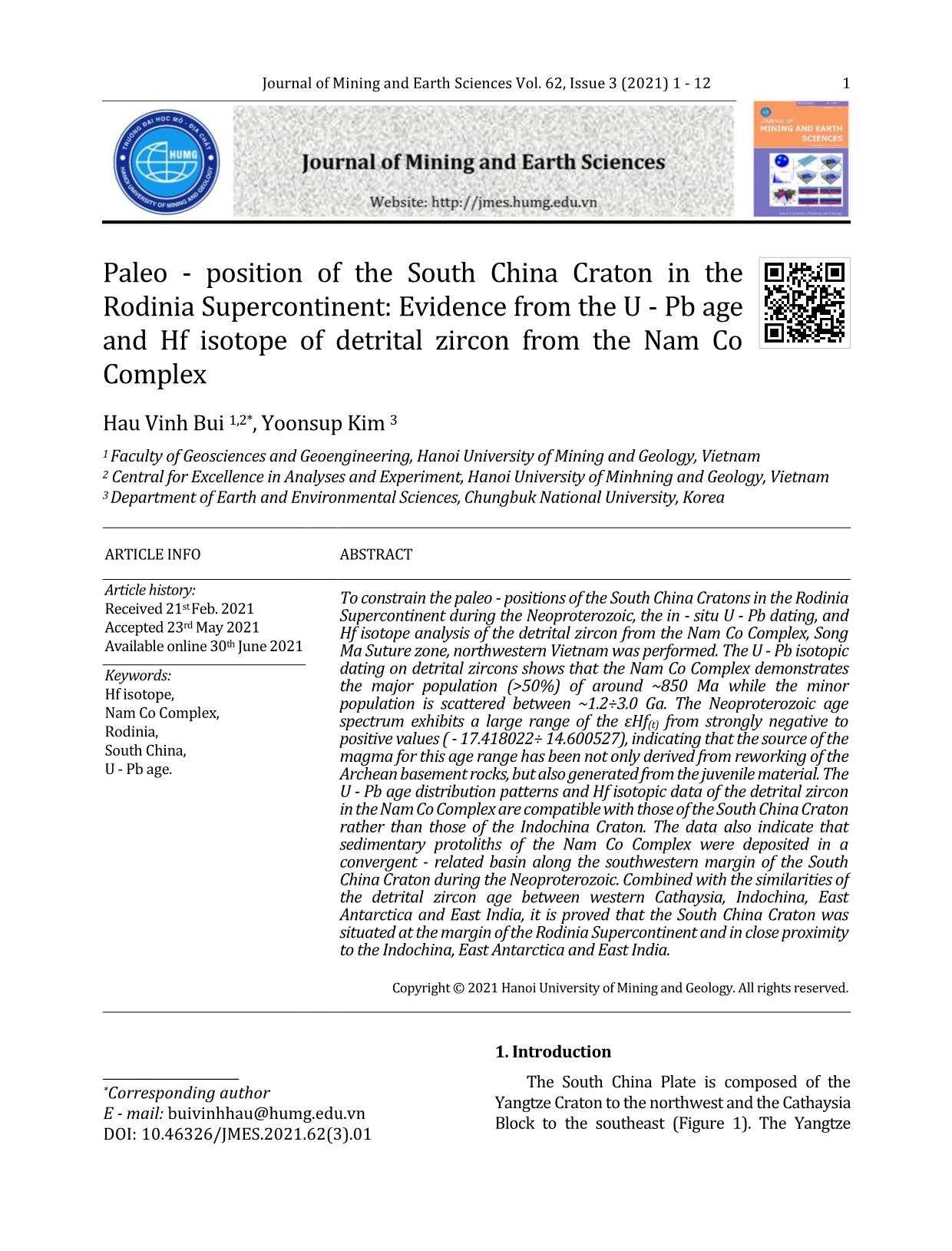
Trang 1
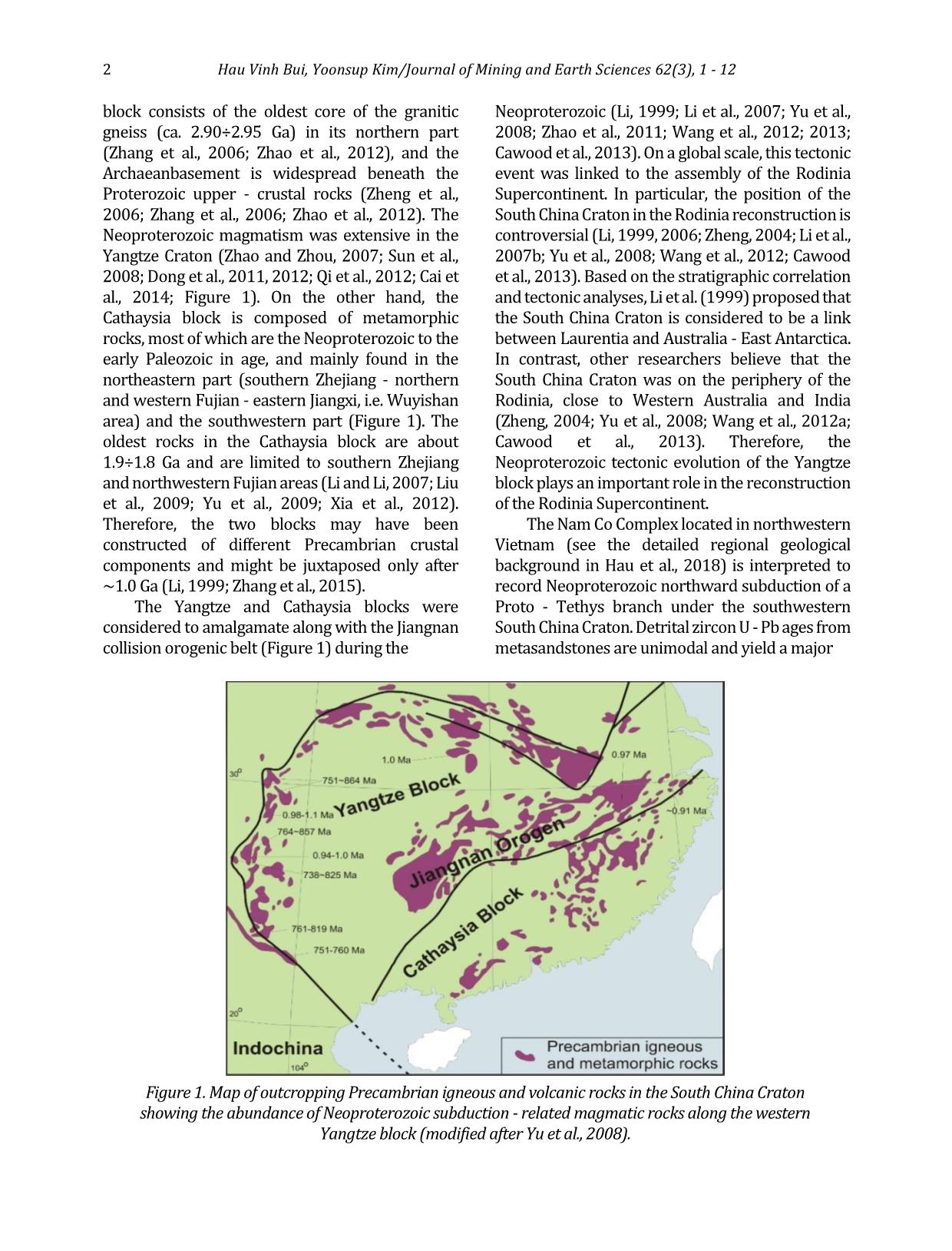
Trang 2
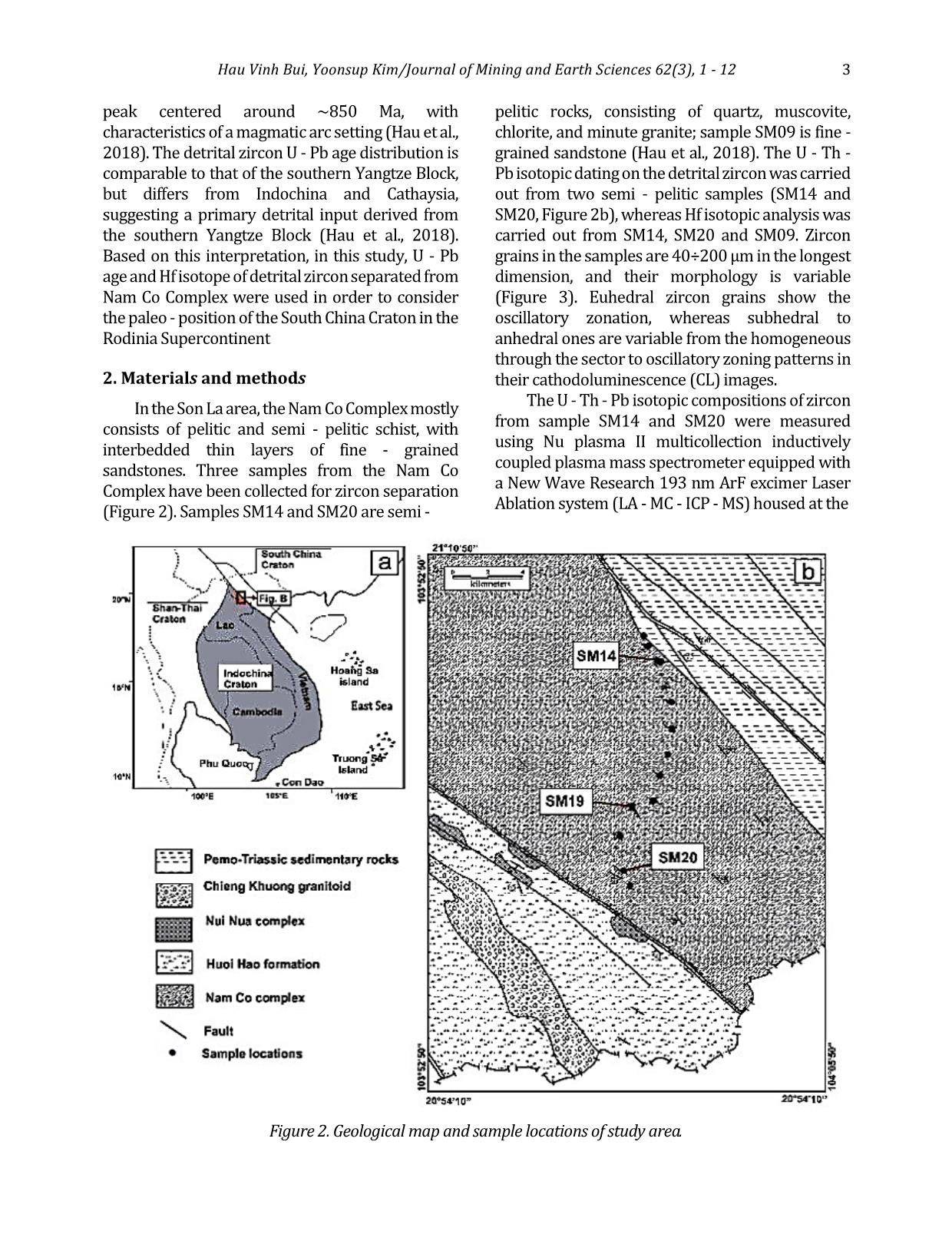
Trang 3
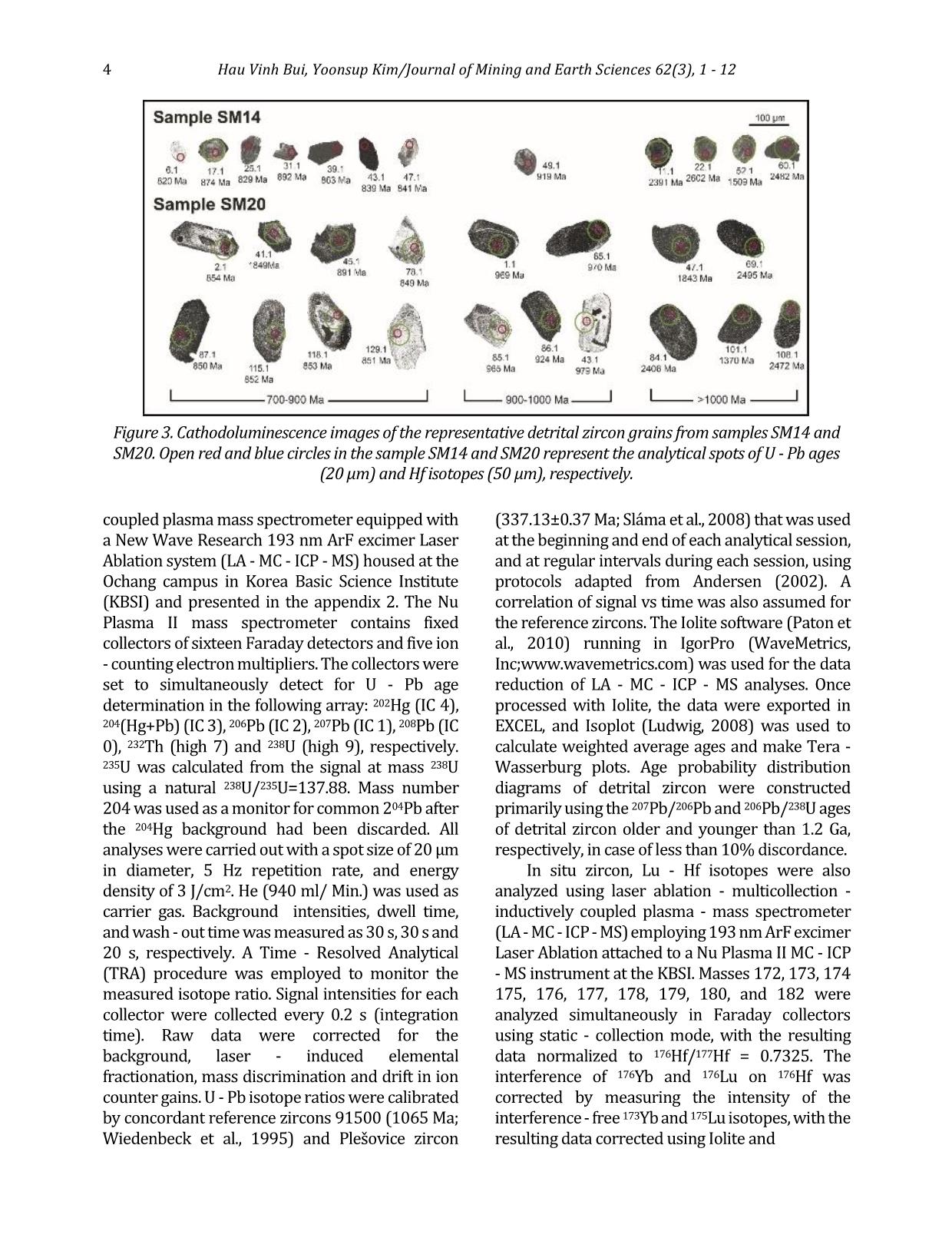
Trang 4
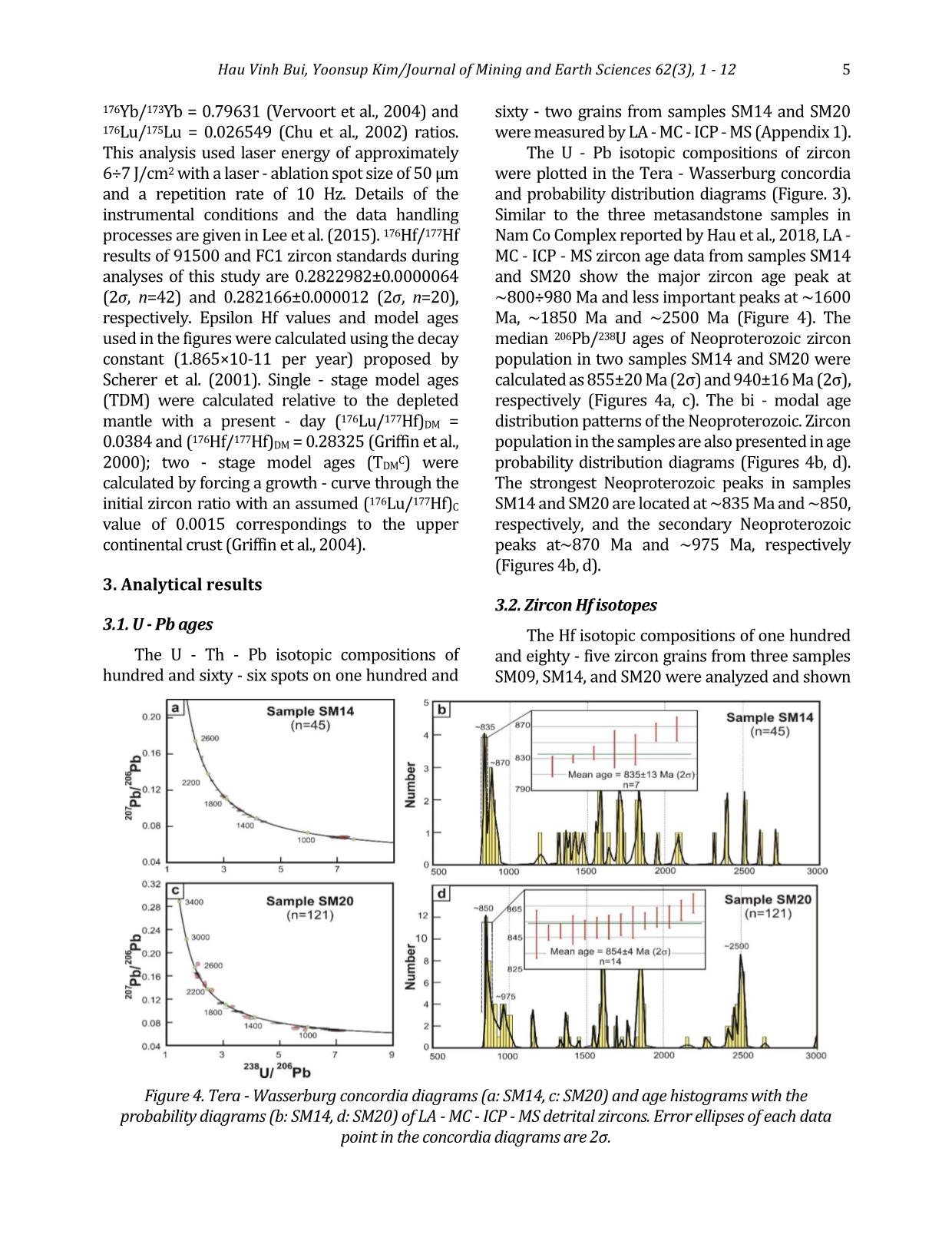
Trang 5
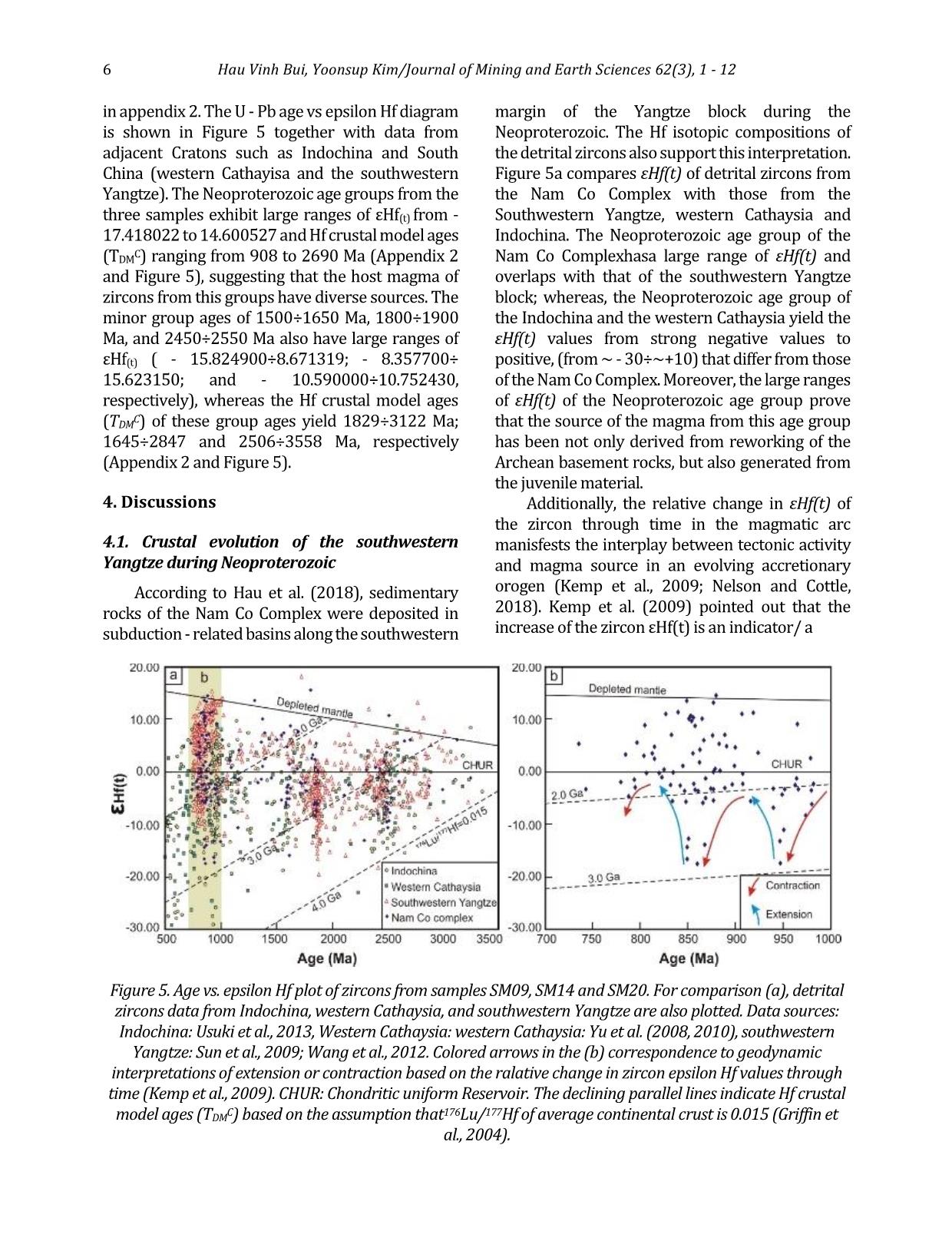
Trang 6
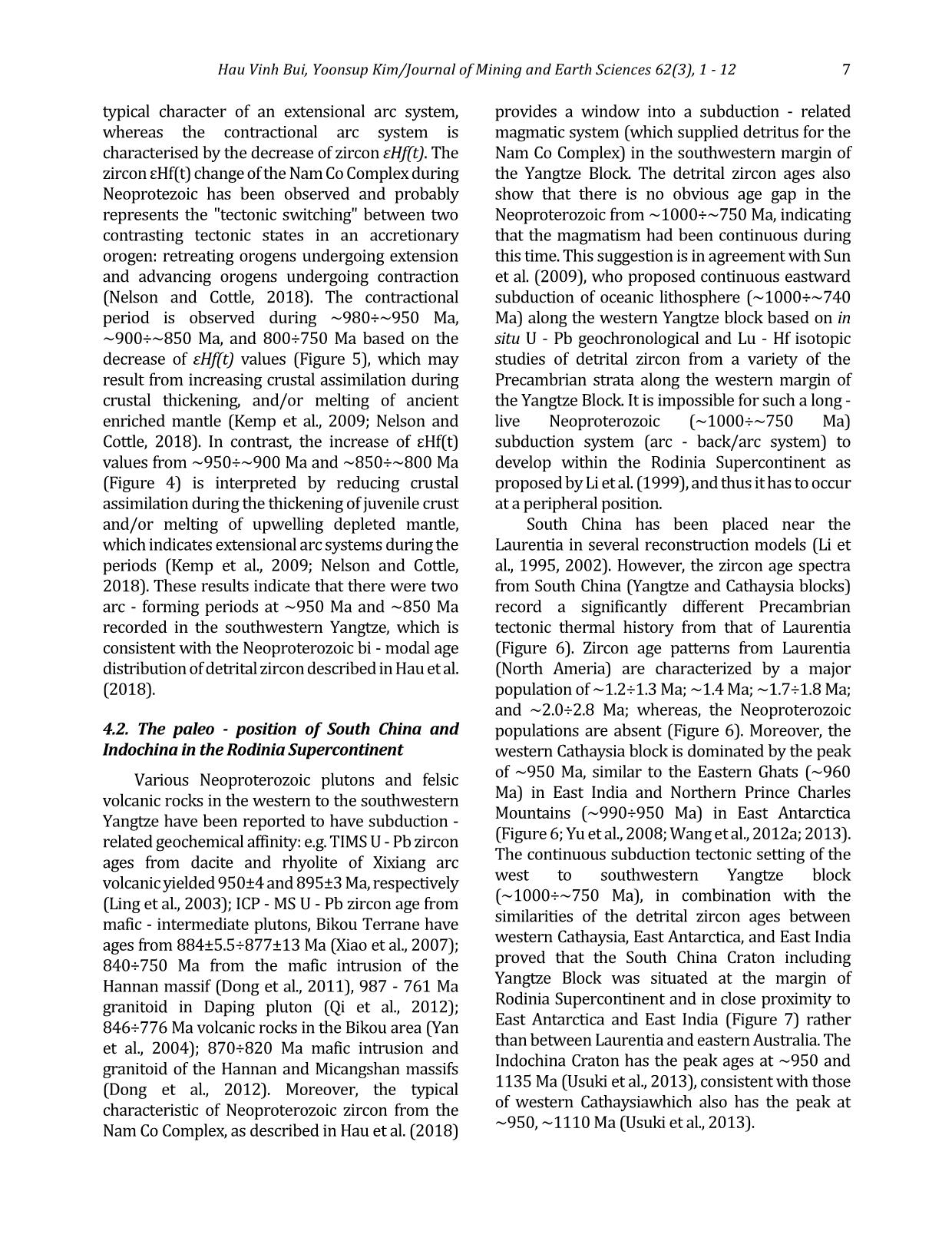
Trang 7
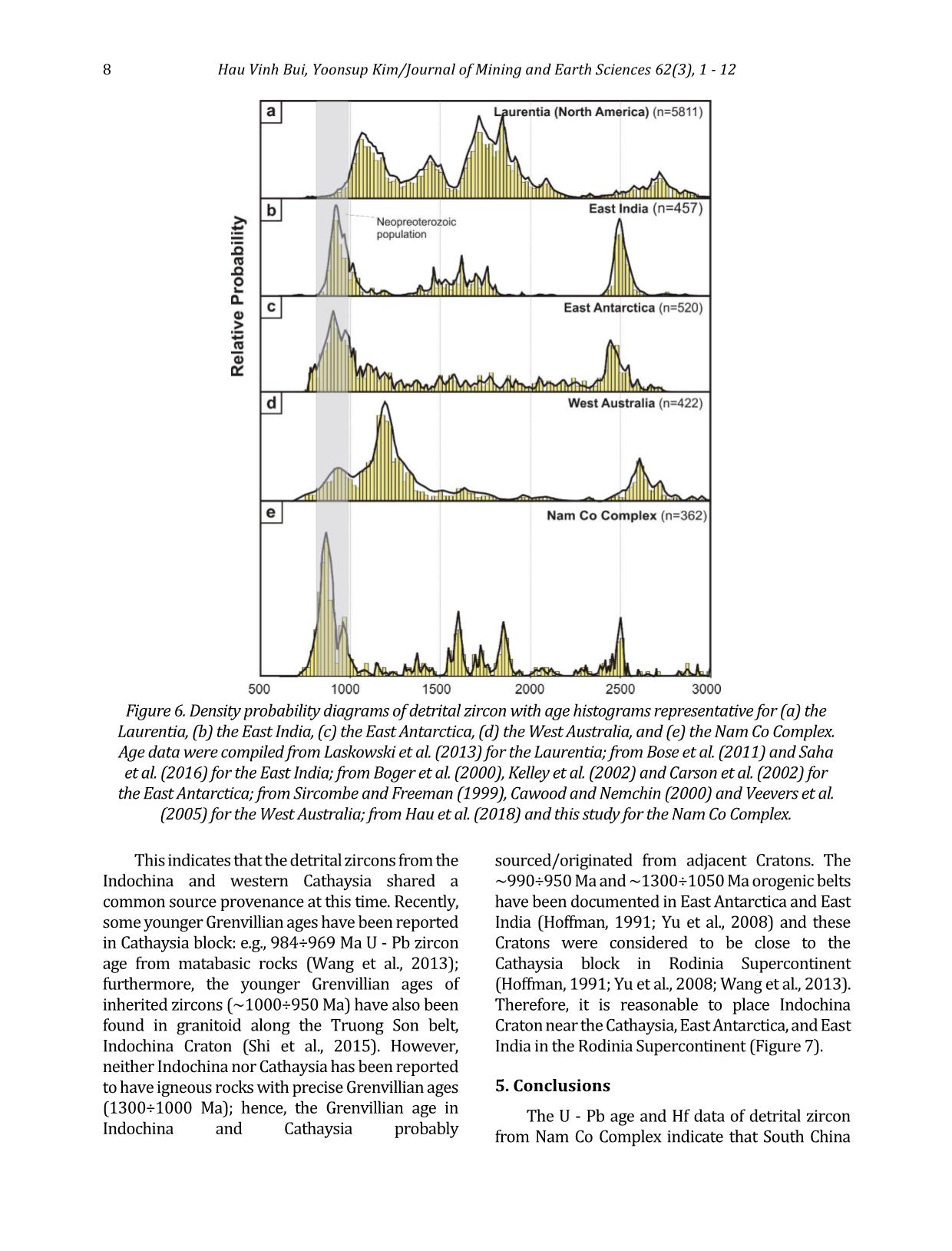
Trang 8
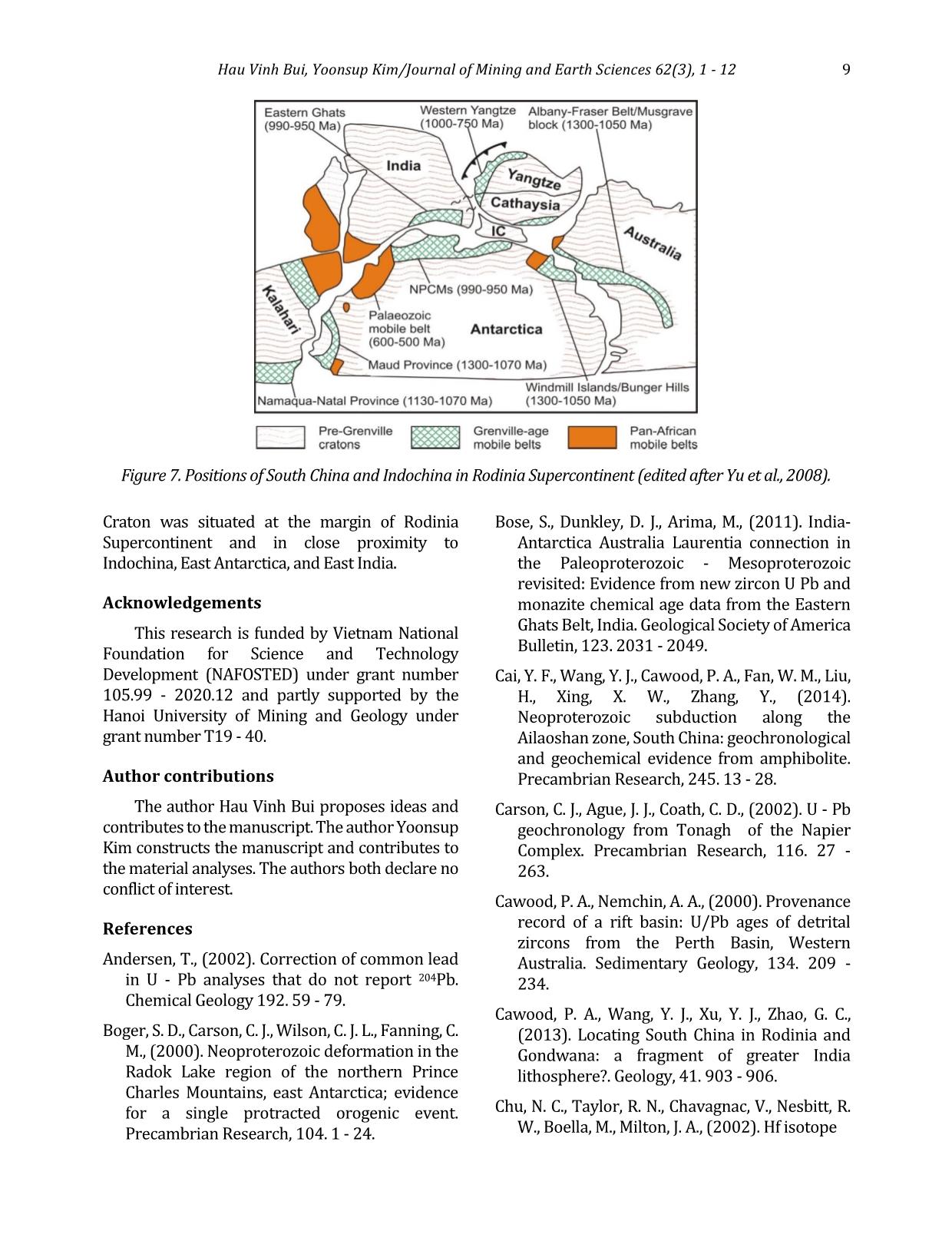
Trang 9
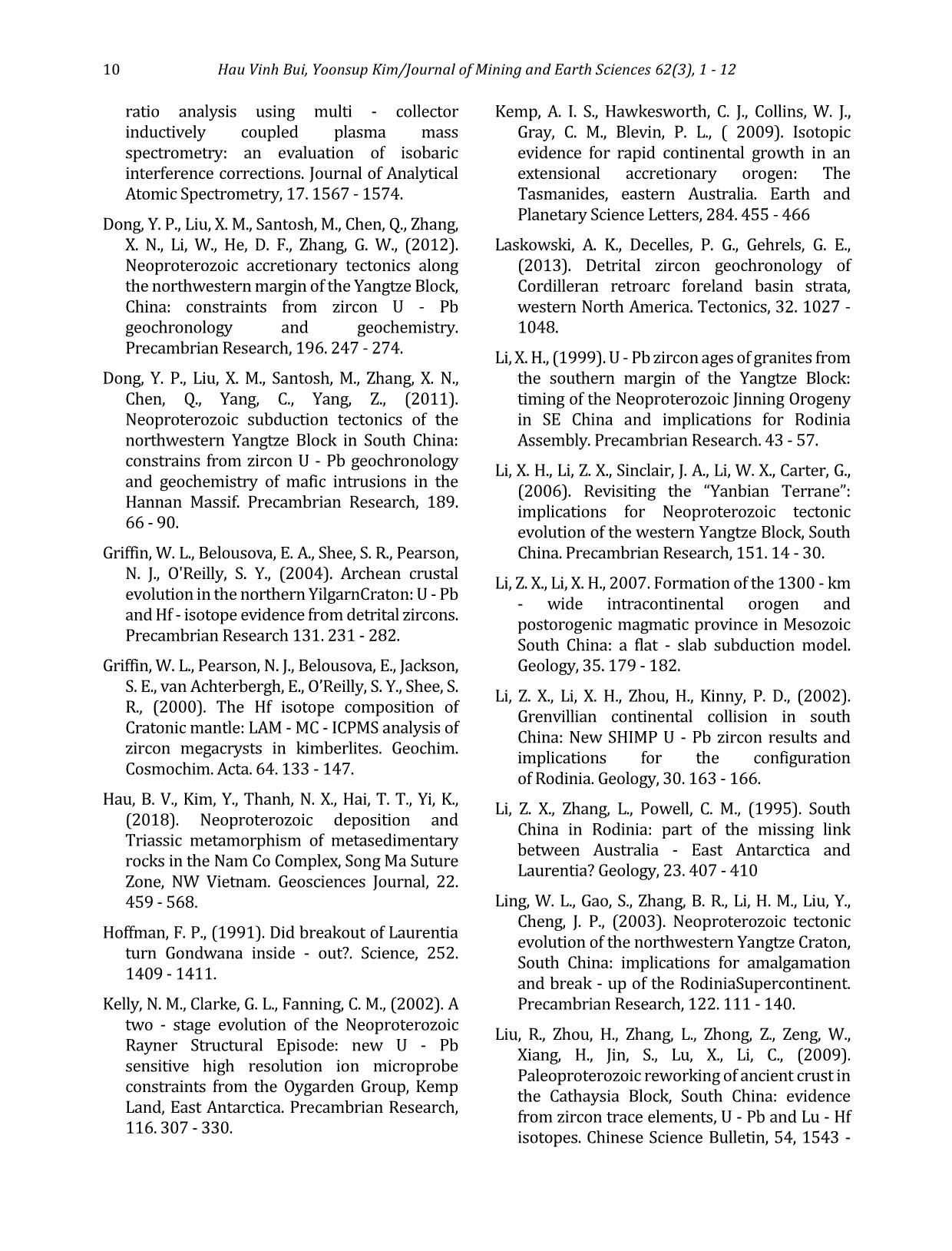
Trang 10
Tải về để xem bản đầy đủ
Tóm tắt nội dung tài liệu: Paleo - Position of the South China Craton in the Rodinia Supercontinent: Evidence from the U - Pb age and Hf isotope of detrital zircon from the Nam Co Complex
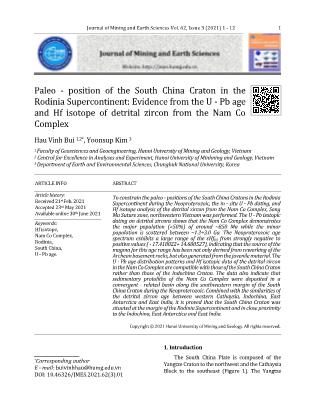
Journal of Mining and Earth Sciences Vol. 62, Issue 3 (2021) 1 - 12 1 Paleo - position of the South China Craton in the Rodinia Supercontinent: Evidence from the U - Pb age and Hf isotope of detrital zircon from the Nam Co Complex Hau Vinh Bui 1,2*, Yoonsup Kim 3 1 Faculty of Geosciences and Geoengineering, Hanoi University of Mining and Geology, Vietnam 2 Central for Excellence in Analyses and Experiment, Hanoi University of Minhning and Geology, Vietnam 3 Department of Earth and Environmental Sciences, Chungbuk National University, Korea ARTICLE INFO ABSTRACT Article history: Received 21st Feb. 2021 Accepted 23rd May 2021 Available online 30th June 2021 To constrain the paleo - positions of the South China Cratons in the Rodinia Supercontinent during the Neoproterozoic, the in - situ U - Pb dating, and Hf isotope analysis of the detrital zircon from the Nam Co Complex, Song Ma Suture zone, northwestern Vietnam was performed. The U - Pb isotopic dating on detrital zircons shows that the Nam Co Complex demonstrates the major population (>50%) of around ~850 Ma while the minor population is scattered between ~1.2÷3.0 Ga. The Neoproterozoic age spectrum exhibits a large range of the εHf(t) from strongly negative to positive values ( - 17.418022÷ 14.600527), indicating that the source of the magma for this age range has been not only derived from reworking of the Archean basement rocks, but also generated from the juvenile material. The U - Pb age distribution patterns and Hf isotopic data of the detrital zircon in the Nam Co Complex are compatible with those of the South China Craton rather than those of the Indochina Craton. The data also indicate that sedimentary protoliths of the Nam Co Complex were deposited in a convergent - related basin along the southwestern margin of the South China Craton during the Neoproterozoic. Combined with the similarities of the detrital zircon age between western Cathaysia, Indochina, East Antarctica and East India, it is proved that the South China Craton was situated at the margin of the Rodinia Supercontinent and in close proximity to the Indochina, East Antarctica and East India. Copyright © 2021 Hanoi University of Mining and Geology. All rights reserved. Keywords: Hf isotope, Nam Co Complex, Rodinia, South China, U - Pb age. 1. Introduction The South China Plate is composed of the Yangtze Craton to the northwest and the Cathaysia Block to the southeast (Figure 1). The Yangtze _____________________ *Corresponding author E - mail: buivinhhau@humg.edu.vn DOI: 10.46326/JMES.2021.62(3).01 2 Hau Vinh Bui, Yoonsup Kim/Journal of Mining and Earth Sciences 62(3), 1 - 12 block consists of the oldest core of the granitic gneiss (ca. 2.90÷2.95 Ga) in its northern part (Zhang et al., 2006; Zhao et al., 2012), and the Archaeanbasement is widespread beneath the Proterozoic upper - crustal rocks (Zheng et al., 2006; Zhang et al., 2006; Zhao et al., 2012). The Neoproterozoic magmatism was extensive in the Yangtze Craton (Zhao and Zhou, 2007; Sun et al., 2008; Dong et al., 2011, 2012; Qi et al., 2012; Cai et al., 2014; Figure 1). On the other hand, the Cathaysia block is composed of metamorphic rocks, most of which are the Neoproterozoic to the early Paleozoic in age, and mainly found in the northeastern part (southern Zhejiang - northern and western Fujian - eastern Jiangxi, i.e. Wuyishan area) and the southwestern part (Figure 1). The oldest rocks in the Cathaysia block are about 1.9÷1.8 Ga and are limited to southern Zhejiang and northwestern Fujian areas (Li and Li, 2007; Liu et al., 2009; Yu et al., 2009; Xia et al., 2012). Therefore, the two blocks may have been constructed of different Precambrian crustal components and might be juxtaposed only after ∼1.0 Ga (Li, 1999; Zhang et al., 2015). The Yangtze and Cathaysia blocks were considered to amalgamate along with the Jiangnan collision orogenic belt (Figure 1) during the Neoproterozoic (Li, 1999; Li et al., 2007; Yu et al., 2008; Zhao et al., 2011; Wang et al., 2012; 2013; Cawood et al., 2013). On a global scale, this tectonic event was linked to the assembly of the Rodinia Supercontinent. In particular, the position of the South China Craton in the Rodinia reconstruction is controversial (Li, 1999, 2006; Zheng, 2004; Li et al., 2007b; Yu et al., 2008; Wang et al., 2012; Cawood et al., 2013). Based on the stratigraphic correlation and tectonic analyses, Li et al. (1999) proposed that the South China Craton is considered to be a link between Laurentia and Australia - East Antarctica. In contrast, other researchers believe that the South China Craton was on the periphery of the Rodinia, close to Western Australia and India (Zheng, 2004; Yu et al., 2008; Wang et al., 2012a; Cawood et al., 2013). Therefore, the Neoproterozoic tectonic evolution of the Yangtze block plays an important role in the reconstruction of the Rodinia Supercontinent. The Nam Co Complex located in northwestern Vietnam (see the detailed regional geological background in Hau et al., 2018) is interpreted to record Neoproterozoic northward subduction of a Proto - Tethys branch under the southwestern South China Craton. Detrital zircon U - Pb ages from metasandstones are unimodal and yield a major Figure 1. Map of outcropping Precambrian igneous and volcanic rocks in the South China Craton showing the abundance of Neoproterozoic subduction - related magmatic rocks along the western Yangtze block (modified after Yu et al., 2008). Hau Vinh Bui, Yoonsup Kim/Journal of Mining and Earth Sciences 62(3), 1 - 12 3 peak centered around ~850 Ma, with characteristics of a magmatic arc setting (Hau et al., 2018). The detrital zircon U - Pb age distribution is comparable to that of the southern Yangtze Block, but differs from Indo ... genic belts have been documented in East Antarctica and East India (Hoffman, 1991; Yu et al., 2008) and these Cratons were considered to be close to the Cathaysia block in Rodinia Supercontinent (Hoffman, 1991; Yu et al., 2008; Wang et al., 2013). Therefore, it is reasonable to place Indochina Craton near the Cathaysia, East Antarctica, and East India in the Rodinia Supercontinent (Figure 7). 5. Conclusions The U - Pb age and Hf data of detrital zircon from Nam Co Complex indicate that South China Figure 6. Density probability diagrams of detrital zircon with age histograms representative for (a) the Laurentia, (b) the East India, (c) the East Antarctica, (d) the West Australia, and (e) the Nam Co Complex. Age data were compiled from Laskowski et al. (2013) for the Laurentia; from Bose et al. (2011) and Saha et al. (2016) for the East India; from Boger et al. (2000), Kelley et al. (2002) and Carson et al. (2002) for the East Antarctica; from Sircombe and Freeman (1999), Cawood and Nemchin (2000) and Veevers et al. (2005) for the West Australia; from Hau et al. (2018) and this study for the Nam Co Complex. Hau Vinh Bui, Yoonsup Kim/Journal of Mining and Earth Sciences 62(3), 1 - 12 9 Craton was situated at the margin of Rodinia Supercontinent and in close proximity to Indochina, East Antarctica, and East India. Acknowledgements This research is funded by Vietnam National Foundation for Science and Technology Development (NAFOSTED) under grant number 105.99 - 2020.12 and partly supported by the Hanoi University of Mining and Geology under grant number T19 - 40. Author contributions The author Hau Vinh Bui proposes ideas and contributes to the manuscript. The author Yoonsup Kim constructs the manuscript and contributes to the material analyses. The authors both declare no conflict of interest. References Andersen, T., (2002). Correction of common lead in U - Pb analyses that do not report 204Pb. Chemical Geology 192. 59 - 79. Boger, S. D., Carson, C. J., Wilson, C. J. L., Fanning, C. M., (2000). Neoproterozoic deformation in the Radok Lake region of the northern Prince Charles Mountains, east Antarctica; evidence for a single protracted orogenic event. Precambrian Research, 104. 1 - 24. Bose, S., Dunkley, D. J., Arima, M., (2011). India- Antarctica Australia Laurentia connection in the Paleoproterozoic - Mesoproterozoic revisited: Evidence from new zircon U Pb and monazite chemical age data from the Eastern Ghats Belt, India. Geological Society of America Bulletin, 123. 2031 - 2049. Cai, Y. F., Wang, Y. J., Cawood, P. A., Fan, W. M., Liu, H., Xing, X. W., Zhang, Y., (2014). Neoproterozoic subduction along the Ailaoshan zone, South China: geochronological and geochemical evidence from amphibolite. Precambrian Research, 245. 13 - 28. Carson, C. J., Ague, J. J., Coath, C. D., (2002). U - Pb geochronology from Tonagh of the Napier Complex. Precambrian Research, 116. 27 - 263. Cawood, P. A., Nemchin, A. A., (2000). Provenance record of a rift basin: U/Pb ages of detrital zircons from the Perth Basin, Western Australia. Sedimentary Geology, 134. 209 - 234. Cawood, P. A., Wang, Y. J., Xu, Y. J., Zhao, G. C., (2013). Locating South China in Rodinia and Gondwana: a fragment of greater India lithosphere?. Geology, 41. 903 - 906. Chu, N. C., Taylor, R. N., Chavagnac, V., Nesbitt, R. W., Boella, M., Milton, J. A., (2002). Hf isotope Figure 7. Positions of South China and Indochina in Rodinia Supercontinent (edited after Yu et al., 2008). 10 Hau Vinh Bui, Yoonsup Kim/Journal of Mining and Earth Sciences 62(3), 1 - 12 ratio analysis using multi - collector inductively coupled plasma mass spectrometry: an evaluation of isobaric interference corrections. Journal of Analytical Atomic Spectrometry, 17. 1567 - 1574. Dong, Y. P., Liu, X. M., Santosh, M., Chen, Q., Zhang, X. N., Li, W., He, D. F., Zhang, G. W., (2012). Neoproterozoic accretionary tectonics along the northwestern margin of the Yangtze Block, China: constraints from zircon U - Pb geochronology and geochemistry. Precambrian Research, 196. 247 - 274. Dong, Y. P., Liu, X. M., Santosh, M., Zhang, X. N., Chen, Q., Yang, C., Yang, Z., (2011). Neoproterozoic subduction tectonics of the northwestern Yangtze Block in South China: constrains from zircon U - Pb geochronology and geochemistry of mafic intrusions in the Hannan Massif. Precambrian Research, 189. 66 - 90. Griffin, W. L., Belousova, E. A., Shee, S. R., Pearson, N. J., O'Reilly, S. Y., (2004). Archean crustal evolution in the northern YilgarnCraton: U - Pb and Hf - isotope evidence from detrital zircons. Precambrian Research 131. 231 - 282. Griffin, W. L., Pearson, N. J., Belousova, E., Jackson, S. E., van Achterbergh, E., O’Reilly, S. Y., Shee, S. R., (2000). The Hf isotope composition of Cratonic mantle: LAM - MC - ICPMS analysis of zircon megacrysts in kimberlites. Geochim. Cosmochim. Acta. 64. 133 - 147. Hau, B. V., Kim, Y., Thanh, N. X., Hai, T. T., Yi, K., (2018). Neoproterozoic deposition and Triassic metamorphism of metasedimentary rocks in the Nam Co Complex, Song Ma Suture Zone, NW Vietnam. Geosciences Journal, 22. 459 - 568. Hoffman, F. P., (1991). Did breakout of Laurentia turn Gondwana inside - out?. Science, 252. 1409 - 1411. Kelly, N. M., Clarke, G. L., Fanning, C. M., (2002). A two - stage evolution of the Neoproterozoic Rayner Structural Episode: new U - Pb sensitive high resolution ion microprobe constraints from the Oygarden Group, Kemp Land, East Antarctica. Precambrian Research, 116. 307 - 330. Kemp, A. I. S., Hawkesworth, C. J., Collins, W. J., Gray, C. M., Blevin, P. L., ( 2009). Isotopic evidence for rapid continental growth in an extensional accretionary orogen: The Tasmanides, eastern Australia. Earth and Planetary Science Letters, 284. 455 - 466 Laskowski, A. K., Decelles, P. G., Gehrels, G. E., (2013). Detrital zircon geochronology of Cordilleran retroarc foreland basin strata, western North America. Tectonics, 32. 1027 - 1048. Li, X. H., (1999). U - Pb zircon ages of granites from the southern margin of the Yangtze Block: timing of the Neoproterozoic Jinning Orogeny in SE China and implications for Rodinia Assembly. Precambrian Research. 43 - 57. Li, X. H., Li, Z. X., Sinclair, J. A., Li, W. X., Carter, G., (2006). Revisiting the “Yanbian Terrane”: implications for Neoproterozoic tectonic evolution of the western Yangtze Block, South China. Precambrian Research, 151. 14 - 30. Li, Z. X., Li, X. H., 2007. Formation of the 1300 - km - wide intracontinental orogen and postorogenic magmatic province in Mesozoic South China: a flat - slab subduction model. Geology, 35. 179 - 182. Li, Z. X., Li, X. H., Zhou, H., Kinny, P. D., (2002). Grenvillian continental collision in south China: New SHIMP U - Pb zircon results and implications for the configuration of Rodinia. Geology, 30. 163 - 166. Li, Z. X., Zhang, L., Powell, C. M., (1995). South China in Rodinia: part of the missing link between Australia - East Antarctica and Laurentia? Geology, 23. 407 - 410 Ling, W. L., Gao, S., Zhang, B. R., Li, H. M., Liu, Y., Cheng, J. P., (2003). Neoproterozoic tectonic evolution of the northwestern Yangtze Craton, South China: implications for amalgamation and break - up of the RodiniaSupercontinent. Precambrian Research, 122. 111 - 140. Liu, R., Zhou, H., Zhang, L., Zhong, Z., Zeng, W., Xiang, H., Jin, S., Lu, X., Li, C., (2009). Paleoproterozoic reworking of ancient crust in the Cathaysia Block, South China: evidence from zircon trace elements, U - Pb and Lu - Hf isotopes. Chinese Science Bulletin, 54, 1543 - Hau Vinh Bui, Yoonsup Kim/Journal of Mining and Earth Sciences 62(3), 1 - 12 11 1554.Ludwig, K. R., (2008). User’s manual for Isoplot 3.6: a geo - chronological toolkit for Microsoft Excel. Berkeley Geochronology Center, Special Publication, 4. 77p. Qi, X. X., Zeng, L. S., Zhu, L. H., Hu, Z. C., Hou, K. J., (2012). Zircon U - Pb and Lu - Hf isotopic systematics of the Daping plutonic rocks: implications for the Neoproterozoic tectonic evolution of the northeastern margin of the Indochina block, Southwest China. Gondwana Research, 21. 180 - 193. Saha, S., Das, K., Hidaka, H., Kimura, K., Pratim, P., Chakraborty, P.P., Hayasaka, Y., (2016). Detrital zircon geochronology (U - Pb SHRIMP and LA - ICPMS) from the Ampani Basin, Central India: Implication for provenance and Mesoproterozoic tectonics at East Indian Cratonic margin. Precambrian Research, 281. 363 - 383. Sircombe, K. N., Freeman, M. J., (1999). Provenance of detrital zircon on the Western Australian coastline - Implications for the geological history of the Perth basin and denudation of the YilgarnCraton. Geology, 27. 879 - 882. Sláma, J., Košler, J., Condon, D. J., Crowley, J. L., Gerdes, A.,Hanchar, J. M., Horstwood, M. S. A., Morris, G. A., Nasdala, L., Norberg, N., Schaltegger, U., Schoene, B., Tubrett, M. N., Whitehouse, M. J., (2008). Plešovice zircon - A new natural reference material for U - Pb and Hf isotopic microanalysis. Chemical Geology, 1 - 2. 1 - 35. Sun, W. H., Zhou, M. F., Gao, J. F., Yang, Y. H., Zhao, X. F., Zhao, J. H., (2009). Detrital zircon U - Pb geochronological and Lu - Hf isotopic constraints on the Precambrian magmatic and crustal evolution of the western Yangtze Block, SW China. Precambrian Research 172. 99 - 126. Sun, W. H., Zhou, M. F., Yan, D. P., Li, J. W., Ma, Y. X., 92008). Provenance and tectonic setting of the Neoproterozoic Yanbian Group, western Yangtze Block (SW China). Precambrian Research, 167. 213 - 236. Usuki, T., Lan, C. Y., Wang, K. L., Chiu, Y., (2013). Linking the Indochina block and Gondwana during the Early Paleozoic: evidence from U - Pb ages and Hf isotopes of detrital zircons. Tectonophysics, 586. 145 - 159. Veevers, J. J., Saeed, A., Belousova, E. A., Griffin, W. L., (2005), U - Pb ages and source composition by Hf - isotope and trace - element analysis of detrital zircons in Permian sandstone and modern sand from southwestern Australia and a review of the paleogeographical and denudational history of the YilgarnCraton. Earth - Science Reviews, 68. 245 - 279. Vervoort, J. D., Patchett, P. J., Söderlund, U., Baker, M., (2004). Isotopic composition of Yb and the determination of Lu concentrations and Lu/Hf ratios by isotope dilution using MC - ICPMS. Geochem. Geophys. Geosystem. 5. 1 - 15. Wang, L. J., Yu, J. H., Griffin, W. L., O'Reilly, S. Y., (2012). Early crustal evolution in the western Yangtze Block: evidence from U - Pb and Lu - Hf isotopes on detrital zircons from sedimentary rocks. Precambrian Research, 222 - 223. 368 - 385. Wang, Y., Zhang, A., Cawood, P. A., Fan, W., Xu, J., Zhang, G., Zhang, Y.,(2013). Geochronological, geochemical and Nd - Hf - Os isotopic fingerprinting of an early Neoproterozoic arc - back - arc system in South China and its accretionary assembly along the margin of Rodinia. Precambrian Research, 231. 343 - 371. Wiedenbeck, M., Allé, P., Corfu, F., Griffin, W. L., Meier, M., Oberli, F., von Quadt, A., Roddick, J. C., Spiegel, W., (1995). Three natural zircon standards for U - Th - Pb, Lu - Hf, trace element and REE analyses. Geostandards Newsletter 19. 1 - 23. Xia, Y., Xu, X. S., Zhu, K. Y., (2012). Paleoproterozoic S - and A - type granites in southwestern Zhejiang: magmatism, metamorphism and implications for the crustal evolution of the Cathaysia basement. Precambrian Research, 216 - 219. 177 - 207. Xiao, L., Zhang, H. F., Ni, P. Z., Xiang, H., Liu, X. M., (2007). LA - ICP - MS U - Pb zircon geochronology of early Neoproterozoic mafic - intermediate intrusions from NW margin of the Yangtze Block, South China: implications 12 Hau Vinh Bui, Yoonsup Kim/Journal of Mining and Earth Sciences 62(3), 1 - 12 for tectonic evolution. Precambrian Research, 154. 221 - 235. Yu, J. H., O'Reilly, S. Y., Wang, L., Griffin, W. L., Zhang, M., Wang, R., Jiang, S., Shu, L., (2008). Where was South China in the RodiniaSupercontinent? evidence from U - Pb geochronology and Hf isotopes of detrital zircons. Precambrian Research, 164. 1 - 15. Yu, J. H., O'Reilly, S. Y., Wang, L., Griffin, W. L., Zhou, M. F., Zhang, M., Shu, L., (2010). Components and episodic growth of Precambrian crust in the Cathaysia Block, South China: evidence from U - Pb ages and Hf isotopes of zircons in Neoproterozoic sediments. Precambrian Research, 181. 97 - 114. Zhang, S. B., Zheng, Y. F., Wu, Y. B., Zhao, Z. F., Gao, S., Wu, F. Y., (2006). Zircon U - Pb age and Hf isotope evidence for 3.8 Ga crustal remnant and episodic reworking of Archean crust in South China. Earth and Planetary Science Letters, 252. 56 - 71. Zhang, Y., Wang, Y., Zhang, Y., Zhang, A., (2015). Neoproterozoic assembly of the Yangtze and Cathaysia blocks: Evidence from the Cangshuipu Group and associated rocks along the Central Jiangnan Orogen, South China. Precambrean Research, 269. 18 - 30. Zhao, J. H., Zhou, M. F., (2007). Geochemistry of Neoproterozoic mafic intrusions in the Panzhihua district (Sichuan Province, South China): implications for subduction - related metasomatism in the upper mantle. Precambrian Research, 152. 27 - 47. Zheng, J., Griffin, W. L., O’Reilly, S. Y., Zhang, M., Pearson, N., Yuanming, P.,( 2006). Widespread Archean basement beneath the Yangtze Craton. Geological Society of America Bulletin, 34. 417 - 420. Zheng, Y., (2004). Position of South China in configuration of Neoproterozoic Supercontinent. Chinese Science Bulletin 49. 751 - 753.
File đính kèm:
 paleo_position_of_the_south_china_craton_in_the_rodinia_supe.pdf
paleo_position_of_the_south_china_craton_in_the_rodinia_supe.pdf

